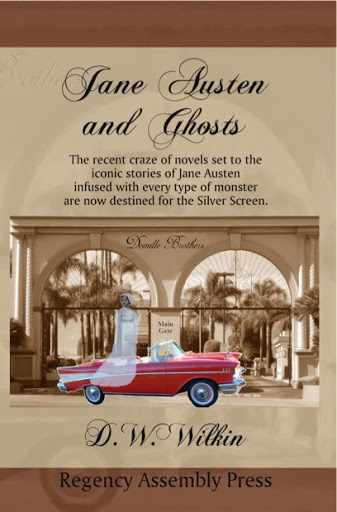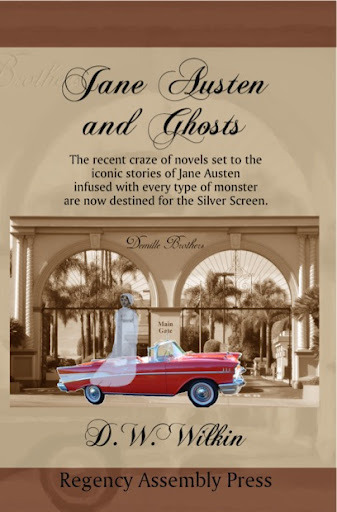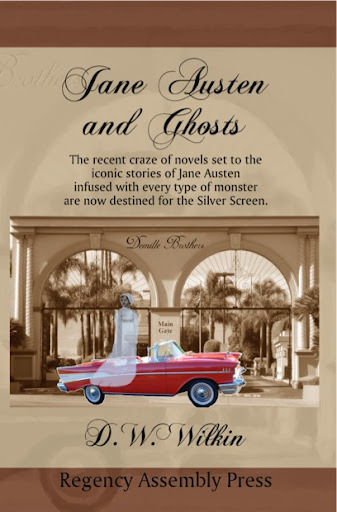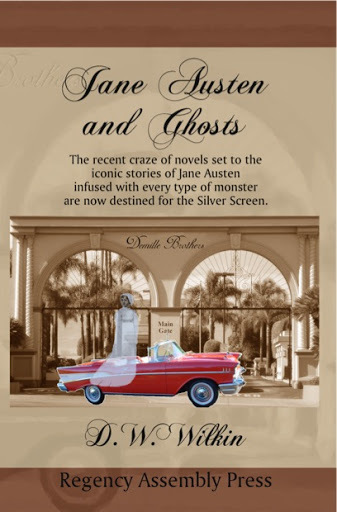D.W. Wilkin's Blog, page 353
May 14, 2012
A Regency Timeline 1788
My last post I explained that I was working on the Regency timeline. Here are 108 entries, a few duplicates I think, and my sources which include the Internet and The Timetables of History as well as the Chronology of Culture should cover a lot of events. There are now over 5000 listed for the period between 1788 and 1837 when Victoria comes to the Throne.
I may post a year at time every so often in between scanning through all these to find something that will be a good article for this blog and the blog at English Historical Fiction Authors. I will also have the full listing up shortly at Regency Assembly Press.
Those who have feedback, it is appreciated or if someone would like a specific year.
1783
19-Dec
Prime Minister of Great Britain: William Pitt “TheYounger”
1788
Jan 1
London’s Daily Universal Register began publishing as The Times.
1788
Jan 1
Quakers in Pennsylvania emancipated their slaves.
1788
Jan 2
Georgia became the fourth state to ratify the U.S. Constitution.
1788
Jan 9
Connecticut became the fifth state to ratify the U.S. Constitution.
1788
Jan 18
The first English settlers arrived in Australia’s Botany Bay to establish a penal colony. They found the location unsuitable and Capt. Arthur Philip moved on to Sydney Cove. England sent the first sheep along with convicts to Australia.
1788
Jan 20
The pioneer African Baptist church was organized in Savannah, Ga.
1788
Jan 22
George Gordon (d.1824), (6th Baron Byron) aka Lord Byron, English poet, was born with a deformed foot. His work included “Lara,” “Childe Harold’s Pilgrimage” and “Don Juan.” He died in Greece at Missolonghi on the gulf of Patras preparing to fight for Greek independence. In 1997 the biography: “Byron: The flawed Angel” by Phyllis Grosskurth was published.
1788
Jan 26
The 1st fleet of ships carrying 736 convicts from England landed at Sydney Cove, New South Wales, Australia. The first European settlers in Australia, led by Capt. Arthur Phillip, landed in present-day Sydney. The day is since known as Australia’s national day. In 2006 Thomas Keneally authored “The Commonwealth of Thieves: The Story of the Founding of Australia.”
1788
Jan 31
Charles Edward Stuart (67), The Young Pretender, “Bonnie Prince Charlie” Stuart dies in Rome Born in 1720
1788
January
January: The first edition of The Times of London is published.
1788
Feb 1
Isaac Briggs and William Longstreet patented the steamboat on this day.
1788
Feb 5
Sir Robert Peel (d.1850), British prime minister through the early 1800s, was born. He founded the Conservative Party and the London Police Force whose officers were called “bobbies.”
1788
Feb 6
Massachusetts became the sixth state to ratify the U.S. Constitution.
1788
Feb 22
Arthur Schopenhauer (d.1860), German philosopher (Great Pessimist), was born: “Hatred comes from the heart; contempt from the head; and neither feeling is quite within our control.”
1788
Mar 7
Alexander Hamilton published his Federalist Paper 65 in the New York Packet. It discussed the subject of impeachment.
1788
Mar 21
Almost the entire city of New Orleans, Louisiana, was destroyed by fire. 856 buildings were burned.
1788
Mar 29
Charles Wesley, hymn writer and brother of John Wesley, died.
1788
Apr 4
Last of the Federalist essays was published. The series of 85 letters were written by Alexander Hamilton, James Madison, and John Jay urging ratification of the US Constitution. Defects in the Articles of Confederation became apparent, such as the lack of central authority over foreign and domestic commerce and the inability of Congress to levy taxes, leading Congress to endorse a plan to draft a new constitution.
1788
Apr 5
Franz Pforr, German painter, cartoonist (Lukasbund), was born.
1788
Apr 12
Carlo Antonio Campioni (67), composer, died.
1788
Apr 15
Mary Delany (b.1700), English artist and writer, died. She became known for her “Flora Delanica,” a collection of 985 botanically accurate portraits of flowers in bloom. In 2011 Molly Peacock authored “”The Paper Garden: An Artist Begins Her Life’s work at 72.”
1788
Apr 28
Maryland became the seventh state to ratify the US constitution, but on condition that a Bill of Rights be added.
1788
May 10
Augustin-Jean Fresnel, optics pioneer, physicist, was born.
1788
May 18
Hugh Clapperton, African explorer, was born in Annan, Scotland.
1788
May 23
South Carolina became the eighth state to ratify the U. S. Constitution.
1788
May 29
Jacques Aliamet (61), French etcher, engraver, died.
1788
May
May: The last volumes of Edward Gibbon’s Decline and Fall of the Roman Empire are published.
1788
Jun 11
The 1st British ship to be built on Pacific coast was begun at Nootka Sound, BC.
1788
Jun 21
The U.S. Constitution went into effect as New Hampshire became the ninth state to ratify it.
1788
Jun 25
Virginia ratified the U.S. Constitution.
1788
Jul 6
Ten thousand troops were called out in Paris as unrest mounted in the poorer districts over poverty and lack of food.
1788
Jul 15
Louis XVI jailed 12 deputies who protest new judicial reforms.
1788
Jul 19
Prices plunged on the Paris stock market.
1788
Jul 20
The governor of the French colony of Pondicherry, Vietnam, abandoned plans to place King Nhuyen Anh back on the throne.
1788
Jul 26
New York became the 11th state to ratify the Constitution.
1788
Aug 2
Thomas Gainsborough (61), English painter, died. His work included the 1771 portraits of the Viscount and Viscountess Ligonier and “Blue Boy.”
1788
Aug 8
King Louis XVI called the French States and Generals together.
1788
Aug 8
Louis FAD Duke de Richelieu (92), French marshal, died.
1788
Aug 27
Jacques Neeker was named French minister of Finance.
1788
August
August: Louis XVI of France agrees to convene the Estates-General for the first time since 1614.
1788
August
August: Mozart composes the “Jupiter Symphony” (Symphony No. 41).
1788
Sep 13
The Congress of the Confederation authorized the first national election, and declared New York City the temporary national capital. The Constitutional Convention authorized the first federal election resolving that electors (electoral college) in all the states will be appointed on January 7, 1789. The Convention decreed that the first federal election would be held on the first Wednesday in February of the following year.
1788
Sep 15
An alliance between Britain, Prussia and the Netherlands was ratified at the Hague.
1788
Sep 19
Charles de Barentin became lord chancellor of France.
1788
Sep 22
Theodore Hook, English novelist best known for “Impromptu at Fulham,” was born.
1788
Sep 23
Louis XVI of France declared the Parliament restored.
1788
Sep 24
After having been dissolved, the French Parliament of Paris reassembled in triumph.
1788
Oct 6
The Polish Diet decided to hold a four year session.
1788
Oct 24
Sarah Josepha Hale, magazine editor and poet whose book Poems for Our Children included “Mary Had a Little Lamb” (the first words to be recorded in sound), was born.
1788
November
November: The first Regency Crisis is brought about by George’s III’s first bout of madness.
1788
Dec 18
Camille Pleyel, Austrian piano builder and composer, was born.
1788
Dec 23
Maryland voted to cede a 100-square-mile area for the seat of the national government; about two-thirds of the area became the District of Columbia.
1788
Dec 30
Francesco Zuccarelli (86), Italian rococo painter and etcher, died.
1788
December
December: King Charles III of Spain dies and is succeeded by his son Charles IV of Spain.
1788
Actor John Philip Kemble becomes manager of the Theatre Royal, Drury Lane.
1788
Botany Bay Colonet established
1788
Sir John Soane begins his re-design of the Bank of England building, the first Greek revival building in England.
1788
The Marylebone Cricket Club codifies the rules of cricket in its Code of Laws, which are universally adopted by the game. (MCC remains the custodian and arbiter of Laws relating to cricket around the world.)
1788
William Playfair, Scottish draughtsman for James Watt, produced an “atlas” of Britain using 44 charts and no maps.
1788
The Marquis de Lafayette wrote the original version of the Declaration of the Rights of Man. He was appalled by the excesses of the revolution and fled to Austria where he was imprisoned for 5 years.
1788
Pierre-Paul Prud’hon (1758-1823), French artist, painted “Love Seduces Innocence, Pleasure Entraps, and Remorse Follows.”
1788
John Adams published “A Defense of the Constitutions.”
1788
“The Narrative of John Blanchford” was published. Blanchford (15), a Massachusetts cabin-boy, had been captured by the British and sent to prison in Halifax and later to Sumatra from where he escaped after a 6 year ordeal.
1788
“The Art of Cookery, Made Plain and Easy” by Hannah Glasse was published in London.
1788
Mozart’s Don Giovanni was performed in conservative Vienna but was not a success.
1788
Mozart composed his 41st symphony titled by his publisher as the Jupiter.
1788
Rules were set for the game of cricket.
1788
“Buffalo clover… nearly knee-high… afforded a rich pasture.” An image of the fertile frontier penned by historian S.P. Hildreth. After 1907 the clover was unseen until 1989 when it emerged in some topsoil delivered to a botanist’s backyard.
1788
As British settlers arrived in Australia the native Aborigines are believed to have numbered about 750,000, and to have inhabited Australia for up to 70,000 years.
1788
A botanical garden opened in Puerto de la Cruz on Tenerife Island (Canary Islands).
1788
A great fire destroyed much of the wooden city of Kyoto, Japan.
1788
A salon from Paris of this time was later transferred [c1993] to the Legion of Honor Museum in San Francisco, Ca.
1788
Louis XVI creates more dissatisfaction by abolishing the power of parliament to review royal edicts. There has been insufficient government planning and storage of grain for emergency shortages. A hailstorm destroys crops. France has its worst harvests in forty years. Winter food riots occur.
1788
Britain’s prisons have been overcrowded, and having lost its thirteen colonies in the Americas it can no longer send convicts there. Instead it sends eleven ships with 1,372 people, including 732 of its more unruly convicts, to a place in Australia named after Lord Sydney, secretary of state for Britain’s colonies.
1788
Parlement of Paris presents list of grievances; Louis XVI decides to call States-General for May 1789 and recalls Jacques Necker as Minister of Finance
1788
Austria declares war on Turkey
1788
British parliamentary motion for abolition of slave trade
1788
Trial of Warren Hastings for maladministration of India
1788
Goethe: “Egmont,” Tragedy
1788
Friendship between Goethe and Schiller
1788
Friedrich Ruckert, german author born
1788
Jospeh von Eichendorff, german romantic poet born
1788
John C Spencer, US Lawyer born
1788
Hannah More: “Thoughts on the Importance of the Manners of the Great to General Society”
1788
John Lempriere:”Classical Dictionary”
1788
Kant: “Critque of Practical Reason,” the “Categorical Imperative
1788
Georg Johann Hamann, German religious philosopher died. (born 1730)
1788
Mozart wrote his las three symphonies in 6 weeks, in E Flat, G Minor and C (Jupiter)
1788
Etelka by Andras Dugonics (1740-1818), playwright, novelist and mathematician. He deplored foreign influences and tried to preserve the native traditions, especially dialects. This was the first popular novel in Hungarian.
1788
First volume of The Scots Musical Museum published by James Johnson (1750-1811) Scottish music engraver who for nearly 40 years had a monopoly of music engraving in Scotland
1788
The Botanicum Uppsala by Jean Louis Desprez (1743-1804) is neo-classicism by a French trained architect
1788
William Savery died (born 1721) Cabinet-maker and carver of the Philadelphia school noted for his elaborate ornament
1788
Humphrey Repton (1752-1818) began to practice as a landscape gardener. His work was on lines developed by Lancelot Brown but on a smaller scale with more details added to Brown’s broad sweeps. In later life he returned to the formal terraces and beds of the French style for the area immediately surrounding the house. Repton is the designer of the grounds of Aspley House.
1788
Kitagawa Utamaro (1753-1806) made a new departure in Ukiyo-E colour prints with his insects, which exploited the accurate observation of Japanese naturalistic painting; he anticipated the work of Hokusai and Kiroshige in this respect, but was chiefly famous for depicting the world of women.
1788
Bread riots in France
1788
First hortensia and fuchsia imported to Europe from Peru
1788
First German Cigar factory opened in Hamburg
1788
James Hutton: “New Theory of the Earth”
1788
Marquis Pierre Simon de Laplace: “Laws of the Planetary System”
1788
KPE Bach died (b 1714)
1788
Brandenburger Tor, Berlin built by CG Langhaus
1788
David: “Love of Paris and Helena”
1788
Maurice Quentin de Latour, French painter died (b 1704)
1788-1789
King George III suffered a mental breakdown.
1788-1792
Koray’s Letters Written from Paris by Adamantios Loraes (1748-1833) man of letters. Greek Scholars and writers were at this time trying to find a language that could be used by all Greeks for all purposes. The choice was between classical (Church) and spoken (demotic) Greek. Koraes attempted a compromise between Church language and spoken Greek, but the result was too artificial.
1788-1800
In 2007 Jay Winik authored “The Great Upheaval: America and the Birth of the Modern World, 1788-1800.”
1788-1865
C.J. Thomson, Danish museum curator, contributed to the Three Age System classification of early man from stone to bronze to iron.








May 3, 2012
The Peterloo Massacre and the writing life
History
This week a little break from the Squares of London. I am not an anarchist, though the history of the Cato Street Conspiracy and now the Massacre might make you think that. What I do with these examples is underscore that all was not well outside the circle of the Ton and that these things that were occurring need to be addressed in our Regency tales. Otherwise they just become faery tales. Our heroes and heroines should have some meat on their bones. They should know some trouble from outside their comfort levels. Jane Austen did us a disservice when she left the war outside of her novels. (Though it opened wide the chance for me to discuss it in Colonel Fitzwilliam’s Correspondence.)
The Peterloo Massacre
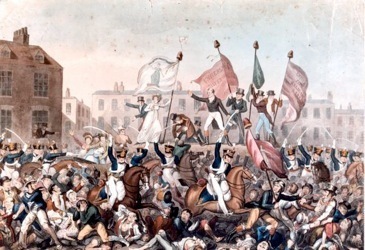
August 16th, 1819 a few months before the Cato Street Conspiracy and some citizens of Manchester decide to peacefully assemble at St. Peter’s Field. That the day would end with 15 civilians dead and the event labelled a massacre has significance. The Boston Massacre not fifty years before resulted in 5 deaths at the hands of British Soldiers. An incident that led to the American Revolution and the loss of the colonies. Today such small numbers would not be labelled massacres, but unfortunate incidents, or riots. During the Georgian period and that of the regency such a headline as 15 dead from these atrocities did not evoke immediate sympathy for innocent women slaughtered by the soldiers, or the first victim, a child of 2, who surely was quite political and a threat, but instead had the government crack down on all those who thought to create sympathy for the victims and for the reason they had gathered together.
That in itself strikes a note about the times and how different they are in that day and age then they are now. Would we want our heroes of our Regency stories to walk into a drawing room and say that they had heard about the massacre. That they felt the government was in top form repressing the action?
After the Napoleonic Wars ended, things were not all well in England. There was famine and unemployment. The introduction of the Corn Laws did not help the populace either. And so by 1819 an unhappy populace were making their voices heard. A gathering in Manchester so that the well known orator, Henry Hunt,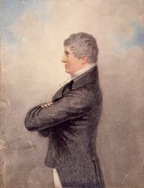 could speak came about.
could speak came about.
The magistrates did not like this and probably did not like that 60,000 to 80,000 people had gathered to hear. Around this time the entire population of Manchester was just over twice that. As a result they decided to arrest Hunt and the others who were speaking on the hustings with him.
Prior to the gathering, a letter had been intercepted where journalist Joseph Johnson wrote to Hunt and suggested that an insurrection was on the horizon. The government sent the 15th Hussars north in case such occurred.
Twice delayed, for at first the meeting was called for on the 2nd of August, the government as well as the organizers each became more concerned. The government sure that the plan was to find new ways to elect MPs and circumvent time honored tradition. After the wars on the continent to maintain the rights of the nobility and the loss of the colonies to the concepts of better representation for the masses, how else could they feel.
The organizers, such as Samuel Bamford, 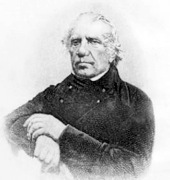 feeling that the endeavor had to be better than ever before urged that an atmosphere of sobriety ensue. They adopted, “Cleanliness, Sobriety, Order and Peace” as a motto for the day. Truly a new way for the english to hold a political gathering. The contingents would march to St. Peter’s Field in good order and they took to drilling until the crown worried that this was in support of the insurrection, outlawed all drilling on August 3rd.
feeling that the endeavor had to be better than ever before urged that an atmosphere of sobriety ensue. They adopted, “Cleanliness, Sobriety, Order and Peace” as a motto for the day. Truly a new way for the english to hold a political gathering. The contingents would march to St. Peter’s Field in good order and they took to drilling until the crown worried that this was in support of the insurrection, outlawed all drilling on August 3rd.
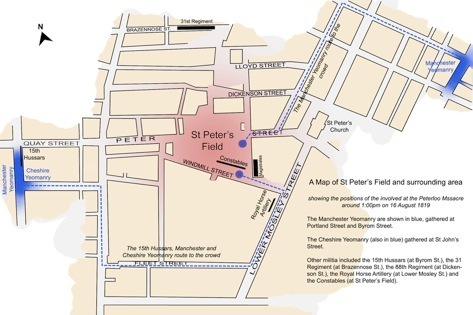
The commander of the british army units in the army was John Byng, 1st Earl of Strafford,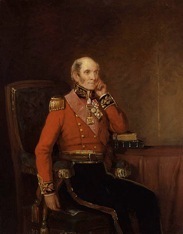 who had two horses entered in the races in York that day. Naturally, as a british aristocrat of the times and the Ton, he was off to the races even though so many had gathered to start an insurrection. In his place he left his second in command, Lt. Colonel Guy L’Estrange who led the 15th Hussars on the 16th as well.
who had two horses entered in the races in York that day. Naturally, as a british aristocrat of the times and the Ton, he was off to the races even though so many had gathered to start an insurrection. In his place he left his second in command, Lt. Colonel Guy L’Estrange who led the 15th Hussars on the 16th as well.
It was perhaps the largest meeting ever to take place in England, and it was done so peaceably. Thousands marched to the meeting, none in anger. Hunt had told all to come armed with only their conscience. We have several journalists in attendance who confirm all this, and the momentous occasion, so many gathered and then what comes next, gives us great documentation.
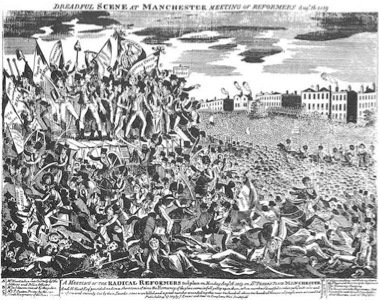
The magistrates, most likely still afraid of an insurrection ordered the arrest of Hunt, but seeing so many people gathered thought that the constables, 200 of them, could not handle the arrest. They sent to the military to request help.
Which came.
Things got out of hand. The constables trying to arrest Hunt found their horses, untrained to be around people so close together, rearing up and crushing them. Finally when the rest was made, the banners that all the contingents had brought in, were set to and the yeomanry helping the constables, started to destroy, which was not in their mandate.
The Hussars arrived and seeing the yeomanry beset as they went above their mission, they naturally needed to defend, especially as the chief magistrate William Hulton urged them to do so. And thus the 15th Hussars formed line and charged into the crowd. It did not help that the exit route so the gathering could disperse was blocked by the 88th Regiment of Foot with their bayonets fixed.
Within a day accounts of the event were published in London, and linking the term Peterloo to connect it to Waterloo was thoughtfully done. The government did not take kindly to this at all and cracked down on reform, instead of those responsible that turned a peaceful meeting into an atrocious event.
Shelley wrote a poem about the events when he heard of them in Italy, The Masque of Anarchy.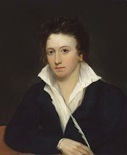
Stand ye calm and resolute,
Like a forest close and mute,
With folded arms and looks which are
Weapons of unvanquished war.
And if then the tyrants dare,
Let them ride among you there,
Slash, and stab, and maim and hew,
What they like, that let them do.
With folded arms and steady eyes,
And little fear, and less surprise
Look upon them as they slay
Till their rage has died away
Then they will return with shame
To the place from which they came,
And the blood thus shed will speak
In hot blushes on their cheek.
Rise like Lions after slumber
In unvanquishable number,
Shake your chains to earth like dew
Which in sleep had fallen on you-
Ye are many — they are few
I released a new book, an omnibus of the three first Trolling stories. In honor of that I have made the first tale of Humphrey and Gwendolyn available for a limited time for $.99  This introductory price is so those who have not discovered this fantasy work can delve into it for a very incentivised price and see if they like the series and continue on, either ordering the other two stories separately, or ordering all three in the Omnibus edition. There are still two more in the series for me to wrap up with edits and release. They have been written as those who follow my blog know. Just not yet gone through my final check protocols.
This introductory price is so those who have not discovered this fantasy work can delve into it for a very incentivised price and see if they like the series and continue on, either ordering the other two stories separately, or ordering all three in the Omnibus edition. There are still two more in the series for me to wrap up with edits and release. They have been written as those who follow my blog know. Just not yet gone through my final check protocols.
The Writing LIfe
I am now almost 150 pages (over 40000 words) into writing on The Crown Imposter. A fantasy that has had two different ideas about for the last few years. Neither was working by when I decided to combine them, all of sudden it worked and I wanted to write. Something I have been too exhausted to do these last few months. I have just completed chapter six and hope that by the next post the end of the story will be in sight.
I enclose a few paragraphs from the first draft and first chapter for perusal.
Chapter 1–the next part
“My cousin, the King of Altan and Duke of Bortell cursed the day that the princes of Altan died. His grandfather, the King of Altan cursed the day that my cousin became his nearest heir. My other cousin, our king though was petitioned by those who lived next to us in Altan that they follow their overlord for he was just and fair. That they become part of Altan when Henry became their king seemed natural. Did you and Master Edvard not say then that this was a good thing?”Middlin had to nod. “Then. Yes then it was a good thing. Now, now it is a tragedy.”
Henry had put aside his wife who was past the age to rear children, having giving two daughters to the man who became the king of the neighboring kingdom. The Altan’s had put pressure on their new king to act so. And then Henry’s first wife was from an old line of Centrion. The birth of a little boy last year to Henry’s second wife had caused great rejoicing in the kingdom of Altan.
King Henry though had started to decline shortly after the birth of his heir. Middlin had kept his thoughts to himself that it was quite suspicious. That the King of Altan was attended by advisors who were related to the new wife, or were those who despised Centrion. The two kingdoms had been enemies more times than they had ever been friends.
Long had those of Altan wished to possess the Duchy of Bortell. The capital of the duchy held the last port along the river Sprag that deep bottom vessels could traverse. From there flat bottom ships journeyed along the tributaries and canals that linked a great deal of Centrion. Bortell was one of the most important trading links that Centrion had.
It had been made a duchy when the first king of Centrion, Bryan, whom Damien had also been named after for he was Damien Bryan Frederick Everheart awarded those lands to the general who married his eldest daughter. A tradition that had continued with every king of Centrion. Dukes and Marquis were raised only from families who had no direct line of male connection to the ruling family. The daughters of the Kings of Centrion had been married to strong men who had become the highest nobility in the land, while those who were the brothers and nephews of the kings of Centrion became the Earls and Barons of the land.
Middlin thought the Barons, like Damien were the spares should the main line falter, but every king had four or five children, since the first Bryan, and that had always been one son, if not more. Except now. King Frederick the third had only one son, and that was Brion. Brion who was not shy about saying his mind about what he thought were the causes of King Henry’s illness.
Damien had taken of his gloves, soaked as was the rest of him and he worked his fingers repeatedly in front of the fire. Cupping his hand and twisting and stretching. With what must have been feeling returning to them, the young man started on the buttons of his cloak. With luck he would be a little warm underneath it, but Middlin did not expect that it to be so.
“Did you have to go to every sentry post?” the sergeant asked, then winced. He had not wanted to keep chewing at that bone, but he had. He shouldn’t worry about the man so. The Baron had to stand firm on his own.
But Middlin thought of Damien as if he were another son. And Middlin had four of his own. Four that he had spent less time with than he had with Damien. The old Baron had asked him to do his best with Damien. And then, when the matter of the Duchy of Altan came upon them all, had come again to say that Damien was going to need even more training now that their barony of Spragfalls, was to become the border between the kingdoms.
“Middlin, do not worry. I shall have a hot drink, or three, and be fine. I shall even be changing all my clothes into fresh ones so that the damp from these stops seeping into my bones. It is quite outside, as you said it would be. Foolish though. Perfect night for someone to stir up trouble. And they know we have the grain fleet here with the canals all swollen from the recent rains.”
“Your cousin King Henry is not dead yet, though he be sick. He would be wroth were there such a blatant attack upon our trade.” And that was something that had not escalated as yet. Three traders had been attacked before reaching Altan and the river port in Bortell. It was why Damien had more sentries and guards out amongst his lands, and here, where most of the waterways came to join the Sprag. But the harvest was in and ready for sale. Tempting prizes should they be taken.








April 25, 2012
Boodles Gentleman’s club, sale on A Trolling We Will Go and the writing life
History
As last week we spent time with Brooks Gentleman’s club, it is only correct that we venture across the street both literally and figuratively and go to Boodles. After this, we should venture to White’s, perhaps the most famous of clubs for the men of the Ton in a future blog and having discussed Waiter’s we should look in there as well in future weeks. My NaNoWriMo novel at the end of last year I have given a work title to of The Other Shoe. While working through it I did some research on Gentleman’s Clubs and thought why not delve into other parts of the Regency besides the Squares I have been reporting on. Many of the scenes of the heroes in our stories are set at their clubs.
Boodles Gentlemen’s Club
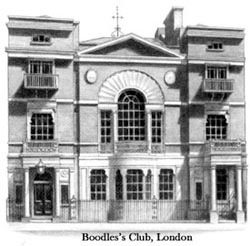
Founded in 1762 by the Earl of Shelburne, William Petty-FitzMaurice who later became the 1st Marquess of Lansdowne and the Prime Minister of England during the last days of the Revolutionary War, or that trifling thing regarding the colonies. (Just a little representation for our taxation and what coulda, shoulda, woulda, wow, think of the possibilities if the americas were still the colonies…)
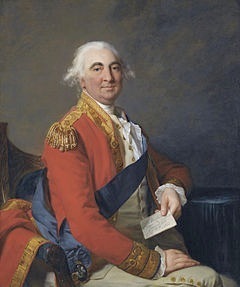
Shelburne was a Whig statement and this club served to be a second place for such to enjoy a day without women in it. It first opened on Pall Mall but in 1782 took over the Savoir Vivre space at 28 St. James Street which is across from Brooks Gentlemen’s club. The club in recent rimes has had such members as Ian Fleming who gave us James Bond, and David Niven who at one time was the Pink Panther…
Such notables who lived during the Regency and were members of the club include menbers we met at Brooks as well. Such as Beau Brummell, William Wilberforce, William Cavendish the 5th Duke of Devonshire. Here we also would see Arthur Wellesley, the 1st Duke of Wellington 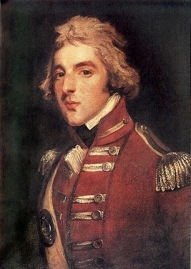 . Also a member was John Fane,
. Also a member was John Fane, 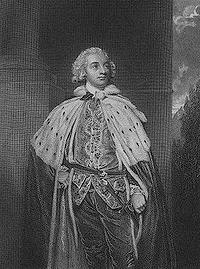 the 10th Earl of Westmoreland who really did run away to Gretna Green to marry Sarah Anne Child
the 10th Earl of Westmoreland who really did run away to Gretna Green to marry Sarah Anne Child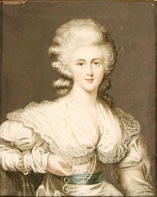 and looked to be a regency beauty as well as the rich daughter of a banker. The banker though cut his daughter and his grandsons from his will. He left his money to his granddaughter so the Fane name would not have access to his fortune.
and looked to be a regency beauty as well as the rich daughter of a banker. The banker though cut his daughter and his grandsons from his will. He left his money to his granddaughter so the Fane name would not have access to his fortune.
So many major men of the Regency were members of Brooks that we have a place to when in London, our heroes will be drawn to for it is the magnet for them socially.
I released a new book, an omnibus of the three first Trolling stories. In honor of that I have made the first tale of Humphrey and Gwendolyn available for a limited time for $.99  This introductory price is so those who have not discovered this fantasy work can delve into it for a very incentivised price and see if they like the series and continue on, either ordering the other two stories separately, or ordering all three in the Omnibus edition. There are still two more in the series for me to wrap up with edits and release. They have been written as those who follow my blog know. Just not yet gone through my final check protocols.
This introductory price is so those who have not discovered this fantasy work can delve into it for a very incentivised price and see if they like the series and continue on, either ordering the other two stories separately, or ordering all three in the Omnibus edition. There are still two more in the series for me to wrap up with edits and release. They have been written as those who follow my blog know. Just not yet gone through my final check protocols.
The Writing LIfe
I am now near 100 pages (about 30000 words, into writing on The Crown Imposter. A fantasy that has had two different ideas about for the last few years. Neither was working by when I decided to combine them, all of sudden it worked and I wanted to write. Something I have been too exhausted to do these last few months
I enclose a few paragraphs from the first draft and first chapter for perusal.
Chapter 1
The door opened letting a cold blast of saturated wetness force it’s way into what should have remained a warm and cozy space. Sergeant Middlin grunted but caught his tongue before he cursed aloud. The young Baron turned as he entered the room and pushed hard to shut the door against the raging storm.
Middlin had sons the Baron’s age. Sons older than the young man if truth were told. He knew holding his tongue was called for at that moment. At least holding some of the obvious things he would say to another man who was not his overlord.
“Everything as it should be?”
The Baron, Damien Everheart, had strode to the blazing fire that they had stoked to greatness once the first signs of the storm had become evident some hours before.
The young man said, “Aye, you were right. All was good. The sentries were in their coveys and hides. You know though I did not go out just to see if they were obeying my orders.” Middlin nodded to that. The Sergeant had charge of the boy, now man, for over a decade. Middlin and a couple others. They had seen to training him for his duties.
Duties, that with his father’s recent death, Damien had now assumed.
“‘Course. Wanting the men to know you share in their burdens earns their trust and respect. I taught you that. But there is a limit. You catch sick from all that water nows that drenched your bones and then the Barony be without a leader.”
Damien smirked a quick laugh, “I’ll stand here in front of the fire and warm myself. I’ll be as dry as bone in three shakes of Spotters tail.” The boy referred to the dog that lay in front of the fire. Old Spot had been a puppy and gift to Damien when he first came to train in the ways of fighting and of ruling. Now the dog had grown old these dozen years since.
“Fool boy. You need to learn that you take care of yourself proper and you don’t need to worry about getting sick. Rushing about in a storm is a sure way to get sick, no matter how long you stand in front of a fire after.” Middlin knew that advice would not be heeded. He probably had heard something the same when he was young from an oldster, and just as Damien, ignored it. Now as his bones knew ache from the cold and wet, he knew the words to be true.
“As you say. But you also taught me about showing myself to the men when they are in hardship. They stand watch in the cold and wet now, and they know I am colder and wetter than they are. And they know that I think it is important what they are doing out there. Standing guard.”
Middlin shook his head. He was not going to win a battle of wits with the Baron. Damien was bright and there was no getting around him for he was stubborn too. And well he should be. He was the lord and now, the Barony was right on the border of the kingdom.
“Your damnable cousin is responsible for all this mess, and for you having to go make the rounds of the watch. Five years ago, his Duchy protected us against the Altans. Now that he is king of all them Altans he caused all the problems that be facing us!” Middlin said with some feeling. He worried that sooner, rather than later, there was going to be war. Prince Brion, the king’s son was hot headed, if all the tales he had heard of that young man were true.
And a hot headed prince was sure to want to make a name for himself. Retaking for the kingdom of Centrion what had been the most prosperous Duchy of the kingdom, and doing so by force of arms, was one way to add the moniker Conqueror to Brion’s name.








April 21, 2012
Brooks Gentleman’s club, sale on A Trolling We Will Go and the writing life
History
This week another break from the Squares of London. My NaNoWriMo novel at the end of last year I have given a work title to of The Other Shoe. While working through it I did some research on Gentleman’s Clubs and thought why not delve into other parts of the Regency besides the Squares I have been reporting on. Many of the scenes of the heroes in our stories are set at their clubs.
Brooks Club
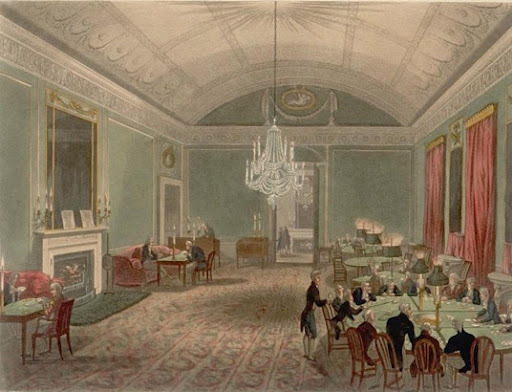
27 men, four of whom were Dukes, set up the club in 1764. It remains one of the most exclusive gentlemen’s clubs still. It was the meeting place for Whigs of the highest rung of the Ton.
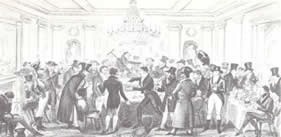
Originally in Pall Mall, it was managed by William Almack who also ran the famed Assembly Rooms with his name. (Managing one place which was the domain of ladies that men were invited to visit, and a place where no ‘Lady’ was invited at all.)
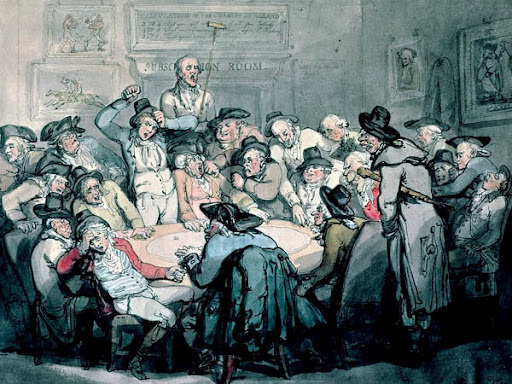
The current building is on St. James Street and was managed by Brooks who survived its opening there in 1778 by only three years. It is across the street from Boodles, the club associated with the Tories.
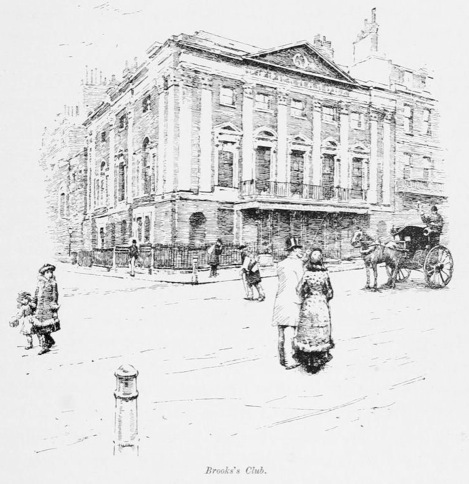
When in London and needing a distraction, riding and hunting being unavailable, the children and the women making such a caterwauling that a lord could just not stand it, what better place to go to then to the club. Here you could meet friends. There was a kitchen that provided large meals, but not great ones. Waiters was thus founded in 1806 for a better dining experience.
Then the gaming rooms became a mainstay of the club. The Betting book at Brooks has many examples of eccentric bets. Some bets so outrageous and impossible for the time that they remain unresolved.
One of the most famous of all the clubs that exist in the Regency period is Brooks. Such notables who lived during the Regency and were members of the club were William Cavendish-Bentinck, the 3rd Duke of Portland who was Prime Minister twice.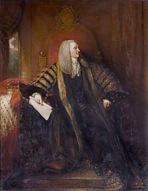 William Cavendish,
William Cavendish,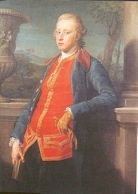 the fifth duke of Devonshire, husband of the incomparable Georgiana
the fifth duke of Devonshire, husband of the incomparable Georgiana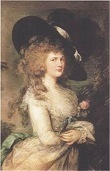 Charles James Fox,
Charles James Fox, 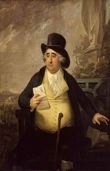 who was the grandson of the 2nd Duke of Richmond, himself a grandson of Charles the II. Fox was the counter to William Pitt the Younger.
who was the grandson of the 2nd Duke of Richmond, himself a grandson of Charles the II. Fox was the counter to William Pitt the Younger.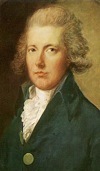 who was the youngest Prime Minister of the United Kingdom first, and then the second time of Great Britain as the way the country was addressed changed its name. Also a member as was his friend, William Wilberforce who was a tireless advocate of the abolition of slavery.
who was the youngest Prime Minister of the United Kingdom first, and then the second time of Great Britain as the way the country was addressed changed its name. Also a member as was his friend, William Wilberforce who was a tireless advocate of the abolition of slavery.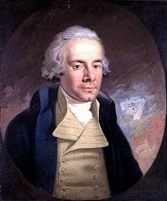 . Yet perhaps the most famous of our members will be he whom we owe the Regency to, George or often referred to in our novels, as Prinny.
. Yet perhaps the most famous of our members will be he whom we owe the Regency to, George or often referred to in our novels, as Prinny.
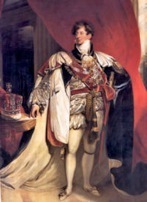
His brothers as well were members, the Duke of York 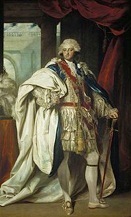 and the Duke of Clarence
and the Duke of Clarence 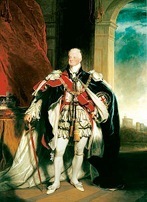 who later became King William the IV. Last we should make note of one regular visitor to the Regency Novels we write. The Beau, Beau Brummell
who later became King William the IV. Last we should make note of one regular visitor to the Regency Novels we write. The Beau, Beau Brummell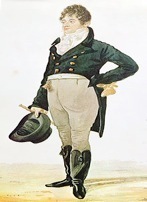 The arbiter of good taste, leader of the Dandy club and known to sit with his friends in the window seat at White’s. He is worthy of his own posting.
The arbiter of good taste, leader of the Dandy club and known to sit with his friends in the window seat at White’s. He is worthy of his own posting.
So many major men of the Regency were members of Brooks that we have a place to when in London, our heroes will be drawn to for it is the magnet for them socially.
I released a new book, an omnibus of the three first Trolling stories. In honor of that I have made the first tale of Humphrey and Gwendolyn available for a limited time for $.99  This introductory price is so those who have not discovered this fantasy work can delve into it for a very incentivised price and see if they like the series and continue on, either ordering the other two stories separately, or ordering all three in the Omnibus edition. There are still two more in the series for me to wrap up with edits and release. They have been written as those who follow my blog know. Just not yet gone through my final check protocols.
This introductory price is so those who have not discovered this fantasy work can delve into it for a very incentivised price and see if they like the series and continue on, either ordering the other two stories separately, or ordering all three in the Omnibus edition. There are still two more in the series for me to wrap up with edits and release. They have been written as those who follow my blog know. Just not yet gone through my final check protocols.
The Writing LIfe
I am not 78 pages (about 24000 words, into writing on The Crown Imposter. A fantasy that have had two different ideas about for the last few years. Neither was working by when I decided to combine them, all of sudden it worked and I wanted to write. Something I have been too exhausted to do these last few months








April 14, 2012
Cato Street Conspiracy
History
This week a little break from the Square of London. My NaNoWriMo novel at the end of last year I have given a work title to of The Other Shoe. While working through it I did some research on the Cato Street Conspiracy and thought why not delve into other parts of the Regency besides the Squares I have been reporting on.
Cato Street Conspiracy
On February 23rd, 1820, not even a month after George the III died, conspirators who planned to murder the entire cabinet of England were captured. On May 1st, 1820, they were executed for these attempted crimes.
That’s pretty swift justice. Today, I should think they would await their execution for more than a decade, and it would probably take a handful of years, rather than two months for the government to put forth their evidence and argue their case in court to convict such criminals.
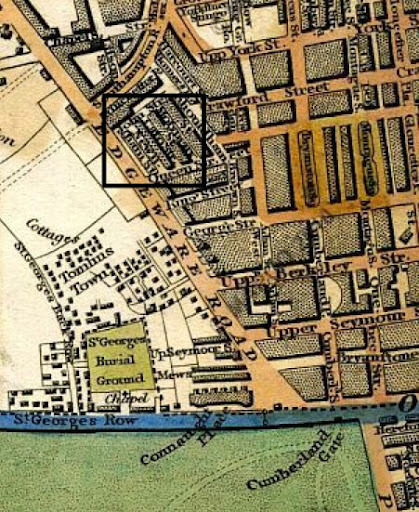
In a world trying to make sense of the great changes that had been occurring for the rights of men for fifty years, and where great wars had been fought that seemed to make progress in other lands but England, one should know that our Regency is and was much affected by these changes, and yet we often never address them in our portrayals of that time of history.
What need the Ton talk of such terrible things of the common man wanting a say in his governance. The fiasco with the colonies and our cousins on the western side of the Atlantic have no concern to us now, surely would be what the minds of our lords and ladies would think were we to question them. Jane Austen certainly has nothing to say of the events that saw the loss of such a great part of the empire. Or even remarks on the war with the little Corporal.
That war Austen’s own brothers went to serve in. That war permeates the era of the Regency.
Liberté, égalité, fraternité
Even once the rest of Europe finishes with the Corsican Tyrant, the movement for more power in the hands of the common man, that we know has changed the America’s and now France, has taken root in England.
And that England responds slowly leads us to the Cato Street Conspiracy. Thwarted because one of the conspirators was actually an informer for the police.
The conspirators went by the name the Spencean Philanthropists. Taking their name from radical speaker Thomas Spence.
They met near Edgeware Road and there is controversy on the manner of their capture, trial and execution. The informer, George Edwards, is also the one responsible for suggesting that the conspirators elevate their game and plan to murder the cabinet ministers. He also planted the newspaper arcticle suggesting that all the cabinet were to dine together and make such a plot plausible. (Right there, changing the names and circumstances is a little would be a good political thriller proving once again that the truth can be stranger than fiction.)
The leader of the Specerians was a man named Arthur Thistlewood,  . The 23rd of February came and Richard Bimie, a Bow Street Magistrate, George Ruthven, and 12 other Bow Street Runners awaited reinforcements from the Coldstream Guards to make an arrest. The command of that detail was under Lt. FitzClarence, George III’s grandson. Growing impatient though, the Runners pushed ahead and in the ensuing arrest, several of the conspirators escaped, to be captured in the next few days. Thistlewood was one, and as he fought for his freedom, he killed Richard Smithers of Bow Street with a sword.
. The 23rd of February came and Richard Bimie, a Bow Street Magistrate, George Ruthven, and 12 other Bow Street Runners awaited reinforcements from the Coldstream Guards to make an arrest. The command of that detail was under Lt. FitzClarence, George III’s grandson. Growing impatient though, the Runners pushed ahead and in the ensuing arrest, several of the conspirators escaped, to be captured in the next few days. Thistlewood was one, and as he fought for his freedom, he killed Richard Smithers of Bow Street with a sword.
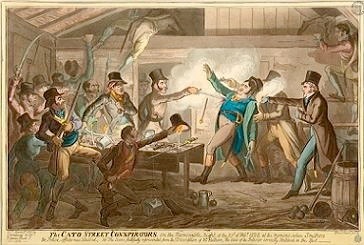
The prosecution convinced two of the conspirators to give testimony against their compatriots and George Edwards, the man who set up the conspirators to elevate their game and then capture them, did not have to speak at the trial at all. The guilty were then sentenced to hung, drawn and quartered. But this was commuted to just hanging and beheading, as the medieval form of punishment was thought too gruesome.
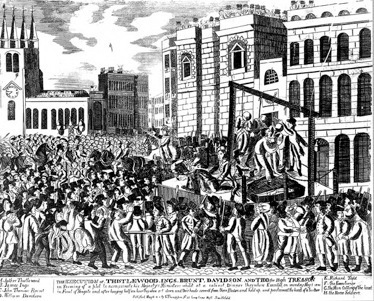
The EXECUTION of THISTLEWOOD, INGS, BRUNT, DAVIDSON, and TIDD for High TREASON
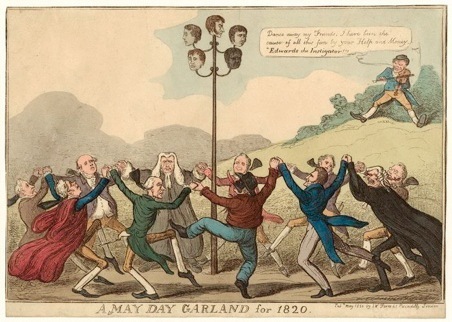
A May Day Garland for 1820
The mere mention of these events should a novel take place around the death of George III 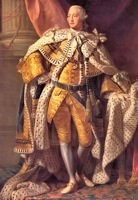 and the coronation of George IV I feel adds depth to our novelizations of the Regency Era. The sentiments that led to such actions were very prevalent. All may be fine in the drawing rooms and ball rooms of the Ton, but below stairs and outside in Town, things were seething, and not just below the surface but very much in the open.
and the coronation of George IV I feel adds depth to our novelizations of the Regency Era. The sentiments that led to such actions were very prevalent. All may be fine in the drawing rooms and ball rooms of the Ton, but below stairs and outside in Town, things were seething, and not just below the surface but very much in the open.
I released a new book, an omnibus of the three first Trolling stories. In honor of that I have made the first tale of Humphrey and Gwendolyn available for a limited time for $.99  This introductory price is so those who have not discovered this fantasy work can delve into it for a very incentivised price and see if they like the series and continue on, either ordering the other two stories separately, or ordering all three in the Omnibus edition. There are still two more in the series for me to wrap up with edits and release. They have been written as those who follow my blog know. Just not yet gone through my final check protocols.
This introductory price is so those who have not discovered this fantasy work can delve into it for a very incentivised price and see if they like the series and continue on, either ordering the other two stories separately, or ordering all three in the Omnibus edition. There are still two more in the series for me to wrap up with edits and release. They have been written as those who follow my blog know. Just not yet gone through my final check protocols.








April 7, 2012
Brampton Square in the Regency (Updated)
History
The location of the lord or ladies home in London is always something I spend time over. And each time I then research the square I use or re-research it. This week I look at Brampton Square.
By looking at the map when Brampton Square was developed we can see that the area was surrounded by the estates of the aristocrats and gentry. What started as a garden on five acres in the 1700s began in March of 1821 to be developed by James Bonnin from a leasehold of Mary Tatham Browne. When she inherited the property, she was a minor, related to the last Prime Serjeant of Ireland Later William Farlar purchased the entire freehold to lease out.
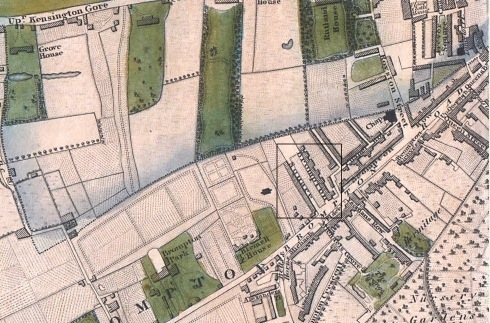
The crescent houses at the North end of the the street were developed between 1824 and 1839. The square was initially home to literary people, artists and theatrical people.
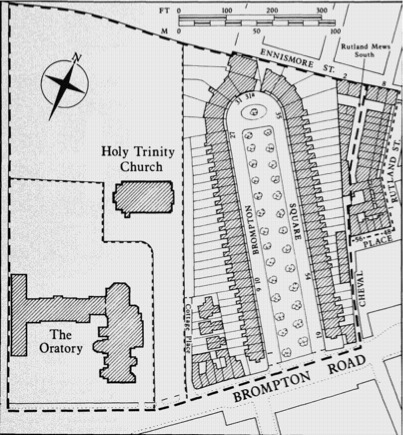
One of the inhabitants of the crescent houses at the North end of the street was the protege of the Duchess of Devonshire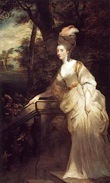 , Henry Luttrell, the wit, and illegitimate son of the 2nd Earl of Carhampton. Luttrell lived at #31
, Henry Luttrell, the wit, and illegitimate son of the 2nd Earl of Carhampton. Luttrell lived at #31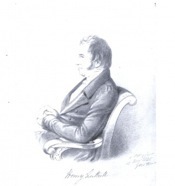 . One of his works, “Advice to Julia, a Letter in Rhyme,’ was published early in 1820. Another was ‘Letters of a Dandy to a Dolly.’ He is further chronicled at the Lansdowne House blog, where one can find that Sir Walter Scott labeled him a “great London wit.”
. One of his works, “Advice to Julia, a Letter in Rhyme,’ was published early in 1820. Another was ‘Letters of a Dandy to a Dolly.’ He is further chronicled at the Lansdowne House blog, where one can find that Sir Walter Scott labeled him a “great London wit.”
O that there might in England be
A duty on Hypocrisy,
A tax on humbug, an excise
On solemn plausibilities!
Another was William Farren, the actor who was a staple at Drury Lane playing Polonius and Caesar during the Regency. Farren lived at #s 23, 25 and 30.
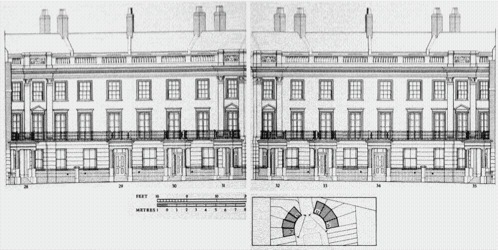
The location of the square is not in the hustle and bustle of London during the Regency period. What I think is advantageous is that is in an area where there are great estates nearby and this would be a good location of those on the verge of mingling with the great of society to actually cross their paths. As Luttrell was introduced to society by his patroness, the Duchess of Devonshire. Another of our heroes, or heroines could easily make their home here and then be within close proximity to their own patron, or love interest.
Jane Austen and Ghosts
The Kindle version has been out for two weeks. It is also available now at Barnes and Noble for your Nook, or at Smashwords. The iTunes edition is also available as is the trade paperwork version so Jane Austen and Ghosts is now physically in print.
You can purchase your copy today at Amazon for $4.99. Or you can purchase at Smashwords, or at Barnes and Noble.
With the availability on the iBookstore for your iPad, and in Trade Paperback, Jane Austen and Ghosts is available at all the outlets that Regency Assembly Press publishes to. The Trade Paperback is now available for $8.99 US and of course available in other currencies for other countries based on that US price. Digital versions across all platforms are $4.99.
Click here to be taken to the webpage on Amazon
A brief synopsis of the story:
In the world of moviemaking, nothing is as golden as rebooting a classic tale that has made fortunes every time before when it has been adapted for the silver screen. Certainly any work by Jane Austen made into a movie will not only be bankable, but also considered a work of art.
That is of course until the current wave of adaptations that unite her classic stories with all the elements of the afterlife is attempted to be created. That these have found success in the marketplace amongst book lovers may not be quite understood by those who make movies. But that they are a success is understood and a reason to make them into movies.
All that being said, perhaps it would also be fair to say that the very proper Jane, were she present to have anything to say about it, would not be pleased. Of course she has been away from this Earth for nearly 200 hundred years. But does that mean were she upset enough, she wouldn’t come back?
Ellis Abbot found stories for tinseltown to make into movies. His most recent find were the batch of stories set in the regency world of Jane Austen. Jane Austen and Monsters.
Meeting with the various authors of those works, it did not seem that Ellis could get one coherent plot of script out of any of them. At least not until he got help from the best source of all.








Brampton Square in the Regency
History
The location of the lord or ladies home in London is always something I spend time over. And each time I then research the square I use or re-research it. This week I look at Brampton Square.
By looking at the map when Brampton Square was developed we can see that the area was surrounded by the estates of the aristocrats and gentry. What started as a garden on five acres in the 1700s began in March of 1821 to be developed by James Bonnin from a leasehold of Mary Tatham Browne. When she inherited the property, she was a minor, related to the last Prime Serjeant of Ireland Later William Farlar purchased the entire freehold to lease out.

The crescent houses at the North end of the the street were developed between 1824 and 1839. The square was initially home to literary people, artists and theatrical people.

One of the inhabitants of the crescent houses at the North end of the street was the protege of the Duchess of Devonshire , Henry Luttrell, the wit, and illegitimate son of the 2nd Earl of Carhampton. Luttrell lived at #31. Another was William Farren, the actor who was a staple at Drury Lane playing Polonius and Caesar during the Regency. Farren lived at #s 23, 25 and 30.
, Henry Luttrell, the wit, and illegitimate son of the 2nd Earl of Carhampton. Luttrell lived at #31. Another was William Farren, the actor who was a staple at Drury Lane playing Polonius and Caesar during the Regency. Farren lived at #s 23, 25 and 30.

The location of the square is not in the hustle and bustle of London during the Regency period. What I think is advantageous is that is in an area where there are great estates nearby and this would be a good location of those on the verge of mingling with the great of society to actually cross their paths. As Luttrell was introduced to society by his patroness, the Duchess of Devonshire. Another of our heroes, or heroines could easily make their home here and then be within close proximity to their own patron, or love interest.
Jane Austen and Ghosts
The Kindle version has been out for two weeks. It is also available now at Barnes and Noble for your Nook, or at Smashwords. The iTunes edition is also available as is the trade paperwork version so Jane Austen and Ghosts is now physically in print.
You can purchase your copy today at Amazon for $4.99. Or you can purchase at Smashwords, or at Barnes and Noble.
With the availability on the iBookstore for your iPad, and in Trade Paperback, Jane Austen and Ghosts is available at all the outlets that Regency Assembly Press publishes to. The Trade Paperback is now available for $8.99 US and of course available in other currencies for other countries based on that US price. Digital versions across all platforms are $4.99.
Click here to be taken to the webpage on Amazon
A brief synopsis of the story:
In the world of moviemaking, nothing is as golden as rebooting a classic tale that has made fortunes every time before when it has been adapted for the silver screen. Certainly any work by Jane Austen made into a movie will not only be bankable, but also considered a work of art.
That is of course until the current wave of adaptations that unite her classic stories with all the elements of the afterlife is attempted to be created. That these have found success in the marketplace amongst book lovers may not be quite understood by those who make movies. But that they are a success is understood and a reason to make them into movies.
All that being said, perhaps it would also be fair to say that the very proper Jane, were she present to have anything to say about it, would not be pleased. Of course she has been away from this Earth for nearly 200 hundred years. But does that mean were she upset enough, she wouldn't come back?
Ellis Abbot found stories for tinseltown to make into movies. His most recent find were the batch of stories set in the regency world of Jane Austen. Jane Austen and Monsters.
Meeting with the various authors of those works, it did not seem that Ellis could get one coherent plot of script out of any of them. At least not until he got help from the best source of all.








March 31, 2012
Clapton Square in the Regency, and an Interview
History
The location of the lord or ladies home in London is always something I spend time over. And each time I then research the square I use or re-research it. This week I look at Clapton Square.
I have never used the square in any of my writings. It was founded in 1816 following on development from of the Church of St John-at-Hackney which was built in 1792.
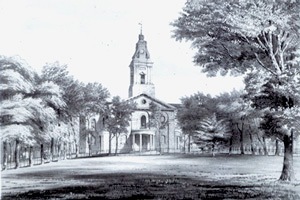
You can see from this drawing from 1830 that the church is surrounded by fields, and so too would be the housing of Clapton Square at the time for it is out in the boondocks of London. Living here would give one the feel of living in a village, just far enough away that you were somewhat countrified, too far to walk to visit any of your neighbors of society. Close enough that a carriage or horse ride would not take very long to pay a social call, or visit the shops a few miles away.
The square was laid out by wealthy brokers from the City to emulate those squares of the West End. Though one may not find the first rank of the Ton about the square, during our period the son of Samuel and Louisa Courtauld was born in a house just off the square. This man, Samuel Courtauld is credited with establishing the famous silversmithing company.
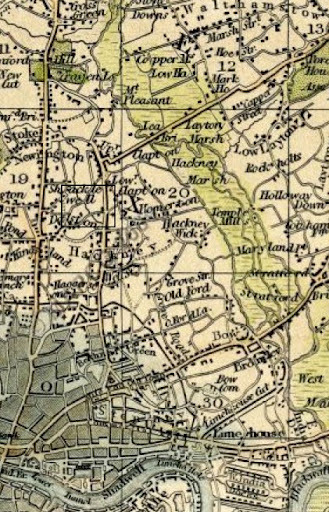
Interview
Once again I was Interviewed, this time at My Jane Austen Book Club. I have been interviewed a few times these last months. As mentioned last week, here is the post of that interview for your entertainment in the next blog. Though please click on the hyperlink and have a visit at Maria's site.
TALKING JANE AUSTEN WITH … DAVID WILKIN
A new "Talking Jane Austen with …" session. My guest today is David Wilkin, author of "Colonel Fitzwilliam's Correspondence" and "Jane Austen and Ghosts". Enjoy our Austen chat!
Welcome at My Jane Austen Book Club, David, and thanks for accepting to talk Jane Austen with me. First of all , do you mind telling us something about yourself?
An evaluation in high school suggested I should either be a businessman or a dancer. So I am a businessman, having spent two decades in the woodworking industry and opening a company that does the wood interiors of restaurants.
The dancing part resulted in my mastering the dances from the mid fifteenth century to modern times, and teaching them. I have run several different regular dance practices, and entire dance weekends of these historic dances.
The fondness for the past does not just extend to the pleasantry of dance, but to the study of the conflicts from which History predominates. War gets a lot written about it. That was perhaps my earliest exposure, army men, leading wargaming, and role-playing games. Or just gaming in general. I was around when the first Computer Gaming magazine debuted. I not only have an extensive library of books, but also games, and play many, not more on computers rather than across the table from an opponent over a board, or with miniatures representing our armies.
The extensive library of books, the vast reading that I have indulged in has also had me turn my hand to writing. Starting with simple sketches while in high school and college to completing novels after graduating. I continue to hone this craft.
What is your opinion? Do you think Jane Austen is very angry for what is happening to her works? Vampires and all kind of monsters have invaded her world!
I think Jane would be very angry at what is happening to her works. From her writing I find that she looked at her society and used her stories to not only comment on society, but t ogive hope to the lives of the woman of her society. She was confined to a certain life based on her birth and that England was a very stratified place to live at the time. Her tales were to give women of the Regency a belief that they could be smart, intelligent and destined for a happy marriage. She wrote before the time of Shelley's Frankenstein and Stoker's Dracula. But as I understand it, the heroine portrayed here in these new adaptations far exceed anything Lizzy Bennet or Emma Woodhouse ever did
However, it seems our world has gone vampire/monsters crazy. Have you got your own interpretation of this phenomenon? Why is our world so attracted by this kind of supernatural characters?
I can't really comment on the attraction of the pheonomena. I really do not like watching flicks that scare me. I like Aliens better than Alien because the Marines attack back. I've read Dracula twice and I can see that it is a literary masterpiece. I have not read much else, Anne Rice, or others, though what I have read in the genre was never as strong as Bram Stoker. My interpretation is based on ghosts of course as the title of my book suggests. For it, I hope I have grasped another romantic influence, Rex Harrison as the Ghost, in the Ghost and Mrs. Muir.
The story in your book is set in the world of moviemaking. Of course, any work by Jane Austen made into a movie is a bankable project, but don't you think that sometimes the screen adaptations might distort the real tone of the novels ?
I live out here in Southern California. For a brief time I worked in "Hollywood" doing a night shift for Dick Clark Productions. I taped every American Bandstand and other productions of the company to send to the copyright office. I made my 15 minute pitch to a producer at the end of my gig, but that didn't fly. So on to other career choices.
For Jane's work, it is very bankable and I think there is an appeal for all regencies that if produced with the right budget, could make a profit amongst those of us who love this era. Of the productions of the work, I think the only fail I can recall is the 1999 Mansfield Park. (Which was one of Cheryl and my first dates) The other that you might call a fail is the 1940 Pride and Prejudice by Huxley and with Olivier and Garson. That however is one of my favorites and why I came to the love the regency era. Edna May Oliver as Lady Catherine is a hoot…
But aside from my favorites and those I don't like your question is if the movies drift from the tone of the novels. We look at the supporting characters I think in Jane's work as caricatures of people and stereotypes so that they enrich the story with humor and pathos. We see the leads as those characters we aspire to be and to have lives as. I think the adaptations in film for the most part hit the mark admirably.
Jane's world is so down-to-earth, all sense and balance do you think fan fiction mostly respect those features?
I have to say, that I have not read much fan fiction based on Jane. I have read the Stephanie Barron mysteries which I love for the footnotes. I have read a few sequels, and then I have my own, Colonel Fitzwilliam's Correspondence. I spent a great deal of time thinking about Colonel Fitzwilliam and the war. The war that Jane ignores a great deal in her writing. Even in Persuasion it is off camera. I don't think you could have lived in England with the war ocurring and not have had it touch you in a much greater way than Jane's characters seem to be effected. For my sequel I did my best to convey the drama that the war could have upon a family, and in this case the Bennets and the Darcys.
Without spending time with a great many other authors in the genre of writing fan fiction based on Jane's work, it would be unfair of me to speak about that. I do know that were one to want to elevate their writing, you need to respect what Jane did with her characters, and you also need to provide characters to have some fun with, as Jane did as well.
What is the appeal of Jane Austen and her world to nowadays readers? What's the secret of her huge global success ?
Jane has always had an appeal. She gives us a Regency world that is clean and bountiful. All of her heroines are part of the lower upper class, or for Fanny Price, quickly sent to an upper class house. How many of us want to be part of the richest wrung of society? Then Jane has kept the underside, the part of the world that does not appeal away. Including the war as I have mentioned.
The Regency may not have been as pretty as the picture Jane has painted, but she did paint it so nicely that it is a canvas that those of us who write Regencies have been able to use ourselves in our endeavors to leave the world as an ideal and not as the reality that it was.
If Jane had lived nowadays what kind of novels would she have written?
I think she would have written literature for women. Strong heroines, and here, instead of class boundaries that kept a women thinking they would have only one avenue in life to pursue, she would have placed them in a dead-end job, or having chosen the wrong career. Something that they would realize and begin to transform themselves, not with the aid of a hero character such as Darcy. The man would be something they would pick up and drag along as they evolved and completed their transformation.
What is it that you best love in her world and in her work?
I love the sense that things do come out for our heroes and heroines. Happy endings may not be how we are going to be rewarded in life, but in fiction, it is a reward I like a great deal.
What is your favourite Austen novel, hero and heroine?
Persuasion is my favorite tale, while I have to say that Elizabeth Bennet is the ultimate heroine. I love Captain Wentworth, but then to have the wealth of Darcy and to be so exceedingly correct and right is something I wish I could live as. Captain Wentworth and his emotions however seem to be more the lot in life for those of us not born to the highest wealth in the land.
As a lover of the Regency and a Janeite what are you next projects to spread more Austen passion?
I've been thinking of perhaps doing something with Margaret Dashwood. Where Colonel Fitzwilliam and history, as well as the last few paragraphs of Pride and Prejudice lent me some firm ideas, Margaret seems a very open character and I do not want to write something that would go to far afield. In the meantime I will release two more, at least, regencies that don't touch on Jane's characters this year. One a classic play on a rich heiress and penniless lord. The other about identical twins whose characters are different even should they look exactly alike. That of course is where the drama, trouble and humor will stem from. I have completed the first drafts of both of these novels and am beginning the second draft.
Could you please tell us something more about your new novel: Jane Austen and Ghosts?
As I mentioned, I spent some time in Hollywood, and then my cousin does exactly what our hero of JAnG does. He reads everything he can to see if the studio could make a good movie from it. I thought of that and the various Zombie, Vampire and Sea Monster books and it came to me that Jane isn't very happy about these works. That they find some way to twist her tales away from the core values.
I then thought that the tale of making these works into a movie, one where as they are doing so, Jane might come back and have a thing or two to say would be humorous. Playing upon that ,the story reflecting a key Jane storyline as well seemed to add to the writing. In the end I have a nicely received short piece that entertains one and all.
Thanks for the interview, I hope that your readers have found this interesting and I am open to answering follow-up questions!
Thanks a lot, David, for being my guest today. Good luck with all your incredible activities and passions!
Jane Austen and Ghosts
The Kindle version has been out for two weeks. It is also available now at Barnes and Noble for your Nook, or at Smashwords. The iTunes edition is also available as is the trade paperwork version so Jane Austen and Ghosts is now physically in print.
You can purchase your copy today at Amazon for $4.99. Or you can purchase at Smashwords, or at Barnes and Noble.
With the availability on the iBookstore for your iPad, and in Trade Paperback, Jane Austen and Ghosts is available at all the outlets that Regency Assembly Press publishes to. The Trade Paperback is now available for $8.99 US and of course available in other currencies for other countries based on that US price. Digital versions across all platforms are $4.99.
Click here to be taken to the webpage on Amazon
A brief synopsis of the story:
In the world of moviemaking, nothing is as golden as rebooting a classic tale that has made fortunes every time before when it has been adapted for the silver screen. Certainly any work by Jane Austen made into a movie will not only be bankable, but also considered a work of art.
That is of course until the current wave of adaptations that unite her classic stories with all the elements of the afterlife is attempted to be created. That these have found success in the marketplace amongst book lovers may not be quite understood by those who make movies. But that they are a success is understood and a reason to make them into movies.
All that being said, perhaps it would also be fair to say that the very proper Jane, were she present to have anything to say about it, would not be pleased. Of course she has been away from this Earth for nearly 200 hundred years. But does that mean were she upset enough, she wouldn't come back?
Ellis Abbot found stories for tinseltown to make into movies. His most recent find were the batch of stories set in the regency world of Jane Austen. Jane Austen and Monsters.
Meeting with the various authors of those works, it did not seem that Ellis could get one coherent plot of script out of any of them. At least not until he got help from the best source of all.








March 24, 2012
Kensington and Sloane Square in the Regency, and an Interview
History
The location of the lord or ladies home in London is always something I spend time over. And each time I then research the square I use or re-research it. This week I look at two squares, Kensington and Sloane. Kensington is the oldest square in London.
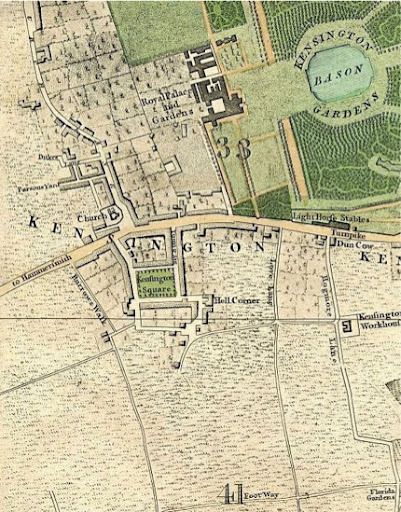
It was founded in 1685 by a wood carver and joiner named Thomas Young, and so by the regency it is well established. However at first it was so far from the action of established London that it might have been doomed to fail if not for the Crown. They established the Royal Palace of Kensington and thus saved the square. It was too late for Thomas Young though. He was deep in debt and imprisoned before this came to pass.
At the time of the Regency Era the Palace is used for minor royalty and it is the home of the young Victoria prior to her ascension to the throne. That the monarchs had left for St. James in the middle of the seventeen hundreds caused the square to go into a slow and gentle decline.
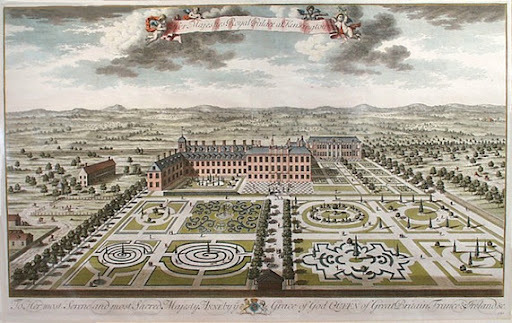
Notables of the Square during the later Regency Era are philosopher John Stuart Mill at #18, and starting in 1830 the Kensington School at #31. By the early 1830s eight academies were in the square, seven of them for boarders.
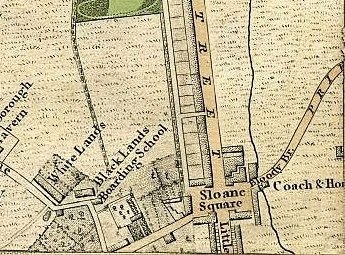
Sloane Square is not as old as Kensington, developed from 1771 and is closer to the center of things. Named after Sir Hans Sloane whose heirs owned the property. Sir Hans was a collector, who bequeathed his items which became the foundation of the British Museum. The square was developed by the father and son architects Henry Holland Senior and Junior. Henry Holland would later work on Prinny's Brighton Pavilion and Carlton House.

Sir Hans Sloane
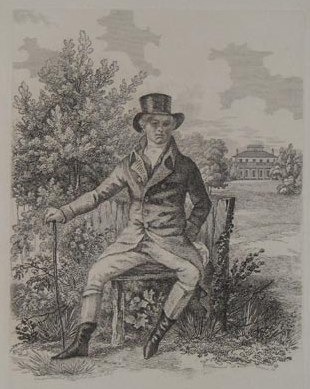
Henry Holland the Architect
Interview
Once again I was Interviewed, this time at My Jane Austen Book Club. I have been interviewed a few times these last months. I will provide here the post of that interview for your entertainment in the next blog. Though please click on the hyperlink and have a visit at Maria's site.
Jane Austen and Ghosts
The Kindle version has been out for two weeks. It is also available now at Barnes and Noble for your Nook, or at Smashwords. The iTunes edition is also available as is the trade paperwork version so Jane Austen and Ghosts is now physically in print.
You can purchase your copy today at Amazon for $4.99. Or you can purchase at Smashwords, or at Barnes and Noble.
With the availability on the iBookstore for your iPad, and in Trade Paperback, Jane Austen and Ghosts is available at all the outlets that Regency Assembly Press publishes to. The Trade Paperback is now available for $8.99 US and of course available in other currencies for other countries based on that US price. Digital versions across all platforms are $4.99.
Click here to be taken to the webpage on Amazon
A brief synopsis of the story:
In the world of moviemaking, nothing is as golden as rebooting a classic tale that has made fortunes every time before when it has been adapted for the silver screen. Certainly any work by Jane Austen made into a movie will not only be bankable, but also considered a work of art.
That is of course until the current wave of adaptations that unite her classic stories with all the elements of the afterlife is attempted to be created. That these have found success in the marketplace amongst book lovers may not be quite understood by those who make movies. But that they are a success is understood and a reason to make them into movies.
All that being said, perhaps it would also be fair to say that the very proper Jane, were she present to have anything to say about it, would not be pleased. Of course she has been away from this Earth for nearly 200 hundred years. But does that mean were she upset enough, she wouldn't come back?
Ellis Abbot found stories for tinseltown to make into movies. His most recent find were the batch of stories set in the regency world of Jane Austen. Jane Austen and Monsters.
Meeting with the various authors of those works, it did not seem that Ellis could get one coherent plot of script out of any of them. At least not until he got help from the best source of all.








Kensington and Sloan Square in the Regency, and an Interview
History
The location of the lord or ladies home in London is always something I spend time over. And each time I then research the square I use or re-research it. This week I look at two squares, Kensington and Sloan. Kensington is the oldest square in London.
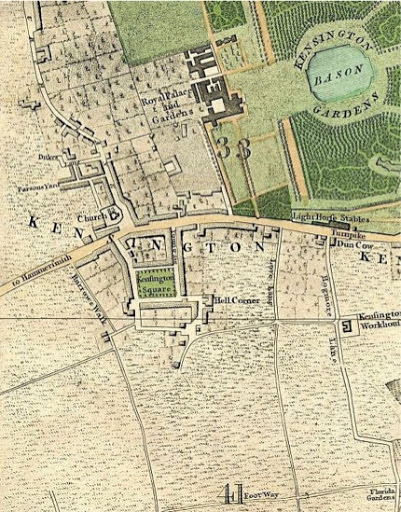
It was founded in 1685 by a wood carver and joiner named Thomas Young, and so by the regency it is well established. However at first it was so far from the action of established London that it might have been doomed to fail if not for the Crown. They established the Royal Palace of Kensington and thus saved the square. It was too late for Thomas Young though. He was deep in debt and imprisoned before this came to pass.
At the time of the Regency Era the Palace is used for minor royalty and it is the home of the young Victoria prior to her ascension to the throne. That the monarchs had left for St. James in the middle of the seventeen hundreds caused the square to go into a slow and gentle decline.
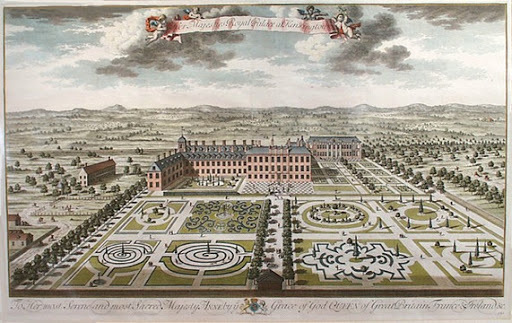
Notables of the Square during the later Regency Era are philosopher John Stuart Mill at #18, and starting in 1830 the Kensington School at #31. By the early 1830s eight academies were in the square, seven of them for boarders.
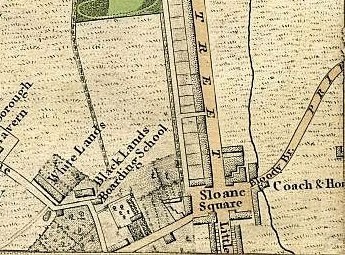
Sloan Square is not as old as Kensington, developed from 1771 and is closer to the center of things. Named after Sir Hans Sloane whose heirs owned the property. Sir Hans was a collector, who bequeathed his items which became the foundation of the British Museum. The square was developed by the father and son architects Henry Holland Senior and Junior. Henry Holland would later work on Prinny's Brighton Pavilion and Carlton House.

Sir Hans Sloane
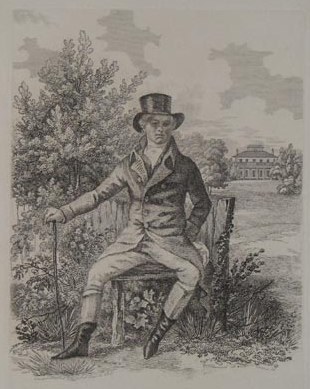
Henry Holland the Architect
Interview
Once again I was Interviewed, this time at My Jane Austen Book Club. I have been interviewed a few times these last months. I will provide here the post of that interview for your entertainment in the next blog. Though please click on the hyperlink and have a visit at Maria's site.
Jane Austen and Ghosts
The Kindle version has been out for two weeks. It is also available now at Barnes and Noble for your Nook, or at Smashwords. The iTunes edition is also available as is the trade paperwork version so Jane Austen and Ghosts is now physically in print.
You can purchase your copy today at Amazon for $4.99. Or you can purchase at Smashwords, or at Barnes and Noble.
With the availability on the iBookstore for your iPad, and in Trade Paperback, Jane Austen and Ghosts is available at all the outlets that Regency Assembly Press publishes to. The Trade Paperback is now available for $8.99 US and of course available in other currencies for other countries based on that US price. Digital versions across all platforms are $4.99.
Click here to be taken to the webpage on Amazon
A brief synopsis of the story:
In the world of moviemaking, nothing is as golden as rebooting a classic tale that has made fortunes every time before when it has been adapted for the silver screen. Certainly any work by Jane Austen made into a movie will not only be bankable, but also considered a work of art.
That is of course until the current wave of adaptations that unite her classic stories with all the elements of the afterlife is attempted to be created. That these have found success in the marketplace amongst book lovers may not be quite understood by those who make movies. But that they are a success is understood and a reason to make them into movies.
All that being said, perhaps it would also be fair to say that the very proper Jane, were she present to have anything to say about it, would not be pleased. Of course she has been away from this Earth for nearly 200 hundred years. But does that mean were she upset enough, she wouldn't come back?
Ellis Abbot found stories for tinseltown to make into movies. His most recent find were the batch of stories set in the regency world of Jane Austen. Jane Austen and Monsters.
Meeting with the various authors of those works, it did not seem that Ellis could get one coherent plot of script out of any of them. At least not until he got help from the best source of all.









